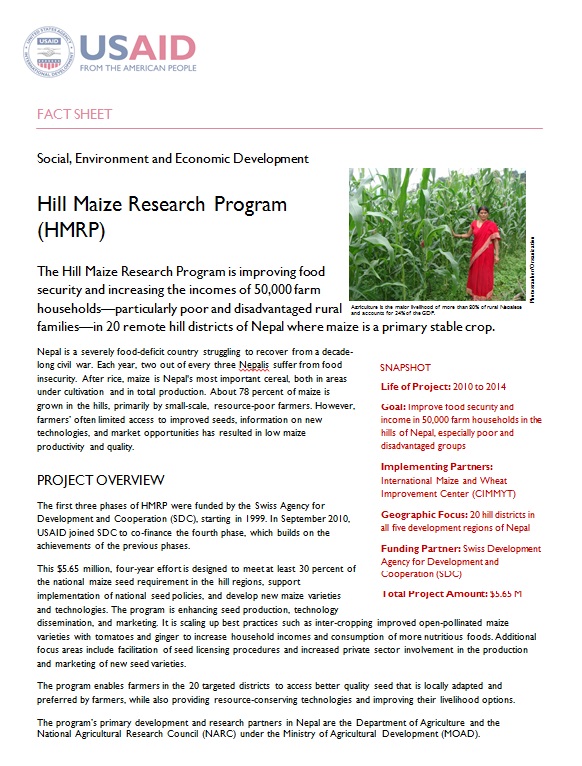The Hill Maize Research Program is improving food security and increasing the incomes of 50,000 farm households—particularly poor and disadvantaged rural families—in 20 remote hill districts of Nepal where maize is a primary stable crop.
Hill Maize Research Program (HMRP) ![]() (docx - 472k)
(docx - 472k)
Nepal is a severely food-deficit country struggling to recover from a decade-long civil war. Each year, two out of every three Nepalis suffer from food insecurity. After rice, maize is Nepal's most important cereal, both in areas under cultivation and in total production. About 78 percent of maize is grown in the hills, primarily by small-scale, resource-poor farmers. However, farmers’ often limited access to improved seeds, information on new technologies, and market opportunities has resulted in low maize productivity and quality.
PROJECT OVERVIEW
The first three phases of HMRP were funded by the Swiss Agency for Development and Cooperation (SDC), starting in 1999. In September 2010, USAID joined SDC to co-finance the fourth phase, which builds on the achievements of the previous phases.
This $5.65 million, four-year effort is designed to meet at least 30 percent of the national maize seed requirement in the hill regions, support implementation of national seed policies, and develop new maize varieties and technologies. The program is enhancing seed production, technology dissemination, and marketing. It is scaling up best practices such as inter-cropping improved open-pollinated maize varieties with tomatoes and ginger to increase household incomes and consumption of more nutritious foods. Additional focus areas include facilitation of seed licensing procedures and increased private sector involvement in the production and marketing of new seed varieties.
The program enables farmers in the 20 targeted districts to access better quality seed that is locally adapted and preferred by farmers, while also providing resource-conserving technologies and improving their livelihood options.
The program’s primary development and research partners in Nepal are the Department of Agriculture and the National Agricultural Research Council (NARC) under the Ministry of Agricultural Development (MOAD).
KEY ACTIVITIES
Increase Productivity and Marketing Opportunities: The program supports adoption of new, profitable maize varieties and improved technologies. It has successfully collaborated with public and private institutions to further develop and disseminate improved technologies, such as crop rotation and intercropping, to farmers. This has resulted in the following:
- Use of improved maize varieties and technologies and better market access for farmers to sell their products.
- Production and marketing of 1,200 kilograms of improved seed through community-based seed production.
- Increased access to drought- and disease-resistant varieties and resource-conserving technologies, which increase productivity and household incomes.
Enhance Seed Quality Control System: The program enables community seed producers to produce better quality maize seed. It promotes seed quality control procedures such as the authorization of truthful labeling of source seed and thereby increases the availability and marketing of more productive, nutritious seed varieties. This has resulted in the following:
- Enhanced local capacity to produce and sell quality seeds in local and regional markets.
- Increased participation of farmers in new maize variety development process alongside researchers and government extension workers.
- Decentralization of quality source seed production and certification -- key steps toward improving efficiency of the seed production system and previously only conducted by the government.
- Implementation of a seed policy and regulatory framework with a sustainable, efficient seed licensing system.
KEY RESULTS
In June 2013, the Government of Nepal (GON) announced plans to replicate HMRP through its Hill Maize Mega Program in non-HMRP hill districts starting in 2013-2014. This HMRP-modeled program is an important step towards institutionalizing HMRP learning and experience in the GON system. The GON will provide subsidies and technical assistance to farmers for improved maize seed equivalent to 2,200 tons. Some of these seeds are from HMRP community-based seed production groups and cooperatives.
Other key impacts of the HMRP include:
- Reached 50,000 hill maize farmers with new, profitable maize varieties and improved technologies through 207 farmer groups/cooperatives.
- Released 7 new open-pollinated maize varieties.
- Started contract farming for maize seed production between farmer groups and traders in 2012, with approximately 200 tons of seeds contracted in 2013, increasing farmer incomes and ensuring reliable high-quality seed supply for traders.
- Increased national maize productivity by 37 percent since 2010.
- Trained 40 seed inspectors from private and public sector institutions as part of a decentralized seed quality control system.








Comment
Make a general inquiry or suggest an improvement.